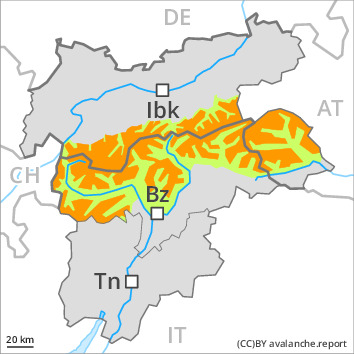
Danger level
 | treeline |
|  |
|  | ||||
|  |
|  |

Weakly bonded old snow represents the main danger. Wind slabs require caution.
Weak layers in the old snowpack can be released over a wide area even by individual winter sport participants, in particular on steep shady slopes above the tree line, as well as in all aspects at elevated altitudes. Whumpfing sounds and the formation of shooting cracks when stepping on the snowpack serve as an alarm indicating the danger. Caution is to be exercised at transitions from a shallow to a deep snowpack. Remotely triggered avalanches are possible.
The fresh and older wind slabs can be released by a single winter sport participant in some cases especially on northwest to north to east facing aspects above the tree line. They are covered with new snow in some cases and therefore difficult to recognise. The prevalence of these avalanche prone locations will increase with altitude.
Mostly the avalanches are medium-sized. Experience in the assessment of avalanche danger is required.
Snowpack
dp.5: snowfall after a long period of cold
dp.6: cold, loose snow and wind
In the north and in the northeast 5 to 20 cm of snow will fall. In the south less snow will fall. Faceted weak layers exist in the centre of the snowpack, in particular on shady slopes above the tree line, as well as on steep sunny slopes at elevated altitudes. Whumpfing sounds and the formation of shooting cracks when stepping on the snowpack confirm the existence of a weak snowack.
The fresh wind slabs will become increasingly prone to triggering at elevated altitudes.
Tendency
As a consequence of the occasionally strong northerly wind, fresh snow drift accumulations will form. As a consequence of falling temperatures the snowpack can not consolidate. This applies in particular at elevated altitudes.




